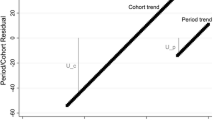Abstract
This comment assesses how age, period and cohort (APC) effects are modelled with panel data in the social sciences. It considers variations on a 2-level multilevel model which has been used to show apparent evidence for simultaneous APC effects. We show that such an interpretation is often misleading, and that the formulation and interpretation of these models requires a better understanding of APC effects and the exact collinearity present between them. This interpretation must draw on theory to justify the claims that are made. By comparing two papers which over-interpret such a model, and another that in our view interprets it appropriately, we outline best practice for researchers aiming to use panel datasets to find APC effects, with an understanding that it is impossible for any statistical model to find and separate all three effects.
Similar content being viewed by others
References
Bell, A., Jones, K.: Another ’futile quest’? A simulation study of Yang and Land’s Hierarchical Age-Period-Cohort model, Working paper (2013)
Clarke, P., O’Malley, P.M., Johnston, L.D., Schulenberg, J.E.: Social disparities in BMI trajectories across adulthood by gender, race/ethnicity and lifetime socio-economic position: 1986–2004. Int. J. Epidemiol. 38(2), 499–509 (2009)
Glenn, N.D.: Cohort analysts futile quest - statistical attempts to separate age, period and cohort effects. Am. Sociol. Rev. 41(5), 900–904 (1976)
Glenn, N.D.: A caution about mechanical solutions to the identification problem in cohort analysis - comment. Am. J. Sociol. 95(3), 754–761 (1989)
Glenn, N.D.: Cohort Analysis, 2nd edn. Sage, London (2005)
Goldstein, H.: Age, period and cohort effects - a confounded confusion. J. Appl. Stat. 6, 19–24 (1979)
Mason, K.O., Mason, W.M., Winsboro, H.H., Poole, K.: Some methodological issues in cohort analysis of archival data. Am. Sociol. Rev. 38(2), 242–258 (1973)
McCulloch, A.: Cohort variation in the membership of volunatary organisations in Great Britain, 1991–2007. Working paper (2012)
Osmond, C., Gardner, M.J.: Age, period, and cohort models - non-overlapping cohorts dont resolve the identification problem. Am. J. Epidemiol. 129(1), 31–35 (1989)
Suzuki, E.: Time changes, so do people. Soc. Sci. Med. 75, 452–456 (2012)
Tawfik, A., Sciarini, P., Horber, E.: Putting voter turnout in a longitudinal and contextual perspective: an analysis of actual participation data. Int. Polit. Sci. Rev. 33(3), 352–371 (2012)
Yang, Y., Land, K.C.: A mixed models approach to the age-period-cohort analysis of repeated cross-section surveys, with an application to data on trends in verbal test scores. Sociol. Methodol. 36, 75–97 (2006)
Author information
Authors and Affiliations
Corresponding author
Rights and permissions
About this article
Cite this article
Bell, A., Jones, K. Current practice in the modelling of age, period and cohort effects with panel data: a commentary on Tawfik et al. (2012), Clarke et al. (2009), and McCulloch (2012). Qual Quant 48, 2089–2095 (2014). https://doi.org/10.1007/s11135-013-9881-x
Published:
Issue Date:
DOI: https://doi.org/10.1007/s11135-013-9881-x




